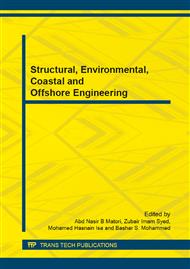[1]
J. Zhang and T. J. Crowley, Historical climate records in China and reconstruction of past climates, Journal of Climate, vol. 2, pp.833-849 %@ 0894-8755, (1989).
DOI: 10.1175/1520-0442(1989)002<0833:hcrica>2.0.co;2
Google Scholar
[2]
A. A. Hassaballa and A. B. Matori, Study on surface moisture content, vegetation cover and air temperature based on NOAA/AVHRR surface temperatures and field measurements, in National Post Graduate Conference NPC, Malaysia, 2011, pp.1-5.
DOI: 10.1109/natpc.2011.6136367
Google Scholar
[3]
J. M. Lanicci, et al., Sensitivity of the Great Plains severe-storm environment to soil-moisture distribution, Monthly Weather Review, vol. 115, pp.2660-2673, (1987).
DOI: 10.1175/1520-0493(1987)115<2660:sotgps>2.0.co;2
Google Scholar
[4]
R. Bindlish and A. P. Barros, Parameterization of vegetation backscatter in radar-based, soil moisture estimation, Remote Sens Environ, vol. 76, pp.130-137 (2001).
DOI: 10.1016/s0034-4257(00)00200-5
Google Scholar
[5]
J. D. Hanson, et al., Calibrating the root zone water quality model, Agronomy Journal, vol. 91, pp.171-177 %@ 0002-1962, (1999).
DOI: 10.2134/agronj1999.00021962009100020002x
Google Scholar
[6]
Z. Su, et al., Preliminary Results of Soil Moisture Retrieval From ESAR (EMAC 94) and ERS-1/SAR, Part II: Soil Moisture Retrieval, 1995, pp.7-19.
Google Scholar
[7]
A. A. Hassaballa, et al., Extraction of soil moisture from RADARSAT-1 and its role in the formation of the 6 December 2008 landslide at Bukit Antarabangsa, Kuala Lumpur, Arabian Journal of Geosciences, pp.1-10 %@ 1866-7511, (2013).
DOI: 10.1007/s12517-013-0990-6
Google Scholar
[8]
H. L. Penman, Natural evaporation from open water, bare soil and grass, Proceedings of the Royal Society of London. Series A. Mathematical and Physical Sciences, vol. 193, pp.120-145 %@ 1364-5021, (1948).
DOI: 10.1098/rspa.1948.0037
Google Scholar
[9]
J. E. Christiansen, Pan evaporation and evapotranspiration from climatic data, Proc Amer Soc Civil Eng, J Irrig Drainage Div, vol. 94, pp.243-265, (1968).
DOI: 10.1061/jrcea4.0000568
Google Scholar
[10]
K. P. Georgakakos and O. W. Baumer, Measurement and utilization of on-site soil moisture data, Journal of hydrology, vol. 184, pp.131-152 %@ 0022-1694, (1996).
DOI: 10.1016/0022-1694(95)02971-0
Google Scholar
[11]
JPM, Basic Population Characteristics By Administrative Districts, Kuala Lumpur2010.
Google Scholar
[12]
T. N. Carlson, et al., A method to make use of thermal infrared temperature and NDVI measurements to infer surface soil water content and fractional vegetation cover, Remote Sensing Reviews, vol. 9, pp.161-173 %@ 0275-7257, (1994).
DOI: 10.1080/02757259409532220
Google Scholar
[13]
R. R. Gillies and T. N. Carlson, Thermal remote sensing of surface soil water content with partial vegetation cover for incorporation into climate models, J. Appl. Meteorol. , vol. 34, pp.745-756 (1995).
DOI: 10.1175/1520-0450(1995)034<0745:trsoss>2.0.co;2
Google Scholar
[14]
F. Becker and Z. -L. Li, Temperature-independent spectral indices in thermal infrared bands, Remote sensing of environment, vol. 32, pp.17-33 %@ 0034-4257, (1990).
DOI: 10.1016/0034-4257(90)90095-4
Google Scholar
[15]
A. A. Hassaballa and A. B. Matori, The estimation of air temperature from NOAA/AVHRR images and the study of NDVI-Ts impact: Case study: The application of split-window algorithms over (Perak Tengah & Manjong) area, Malaysia, in International Conference on Space Science and Communication (IconSpace), Malaysia, 2011, pp.20-24.
DOI: 10.1109/iconspace.2011.6015844
Google Scholar
[16]
M. S. Moran, et al., Estimating crop water deficit using the relation between surface-air temperature and spectral vegetation index, Remote sensing of environment, vol. 49, pp.246-263 %@ 0034-4257, (1994).
DOI: 10.1016/0034-4257(94)90020-5
Google Scholar
[17]
A. A. Van de Griend and M. Owe, On the relationship between thermal emissivity and the normalized difference vegetation index for natural surfaces, Int J Remote Sens vol. 14, pp.1119-1131 (1993).
DOI: 10.1080/01431169308904400
Google Scholar


